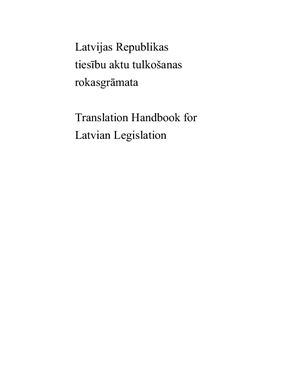R?ga: Tulko?anas un terminolo?ijas centrs, 2000. - 80 c.
Much of the material in this handbook is taken directly or adapted from the European
Commission Translation Service English Style Guide (ECTS-ESG).
1. Some material is adapted from the European Communities Interinstitutional Style Guide (EC-ISG).
2. This Handbook does not attempt to be an all-encompassing English language style guide.
Several excellent style guides already exist (for example the two cited above) and should
be consulted regarding the use of the English language as such.
Accuracy and clarity are crucial aspects of legislative translation. The practical experience
gained and lessons leaed over the past two years by the TTC English Translation Unit
have been incorporated into the Handbook. It is intended to address the specific translation
issues and problems that come up when translating Latvian legislation into English. The
Handbook will also serve as a tool for ensuring consistency in legislative translations.
Chapters 1 to 6 cover general English usage and grammar topics. The following chapters
(7 – 11) address more difficult issues of translation such as gender-neutral language,
transposing geographic names into English, the use of footnotes and so on.
Chapter 12 deals with the use of verbs and appropriate equivalents in legislative texts.
Tables of terms sorted by topic in Chapter 13 and a more extensive list of common legal
terms found in Latvian laws (sorted alphabetically) in Chapter 14 will serve as a quick
reference tool for translators. The three annexes are tables of Latvian and English
equivalents for units of measurement, languages of the world and acronyms.
Much of the material in this handbook is taken directly or adapted from the European
Commission Translation Service English Style Guide (ECTS-ESG).
1. Some material is adapted from the European Communities Interinstitutional Style Guide (EC-ISG).
2. This Handbook does not attempt to be an all-encompassing English language style guide.
Several excellent style guides already exist (for example the two cited above) and should
be consulted regarding the use of the English language as such.
Accuracy and clarity are crucial aspects of legislative translation. The practical experience
gained and lessons leaed over the past two years by the TTC English Translation Unit
have been incorporated into the Handbook. It is intended to address the specific translation
issues and problems that come up when translating Latvian legislation into English. The
Handbook will also serve as a tool for ensuring consistency in legislative translations.
Chapters 1 to 6 cover general English usage and grammar topics. The following chapters
(7 – 11) address more difficult issues of translation such as gender-neutral language,
transposing geographic names into English, the use of footnotes and so on.
Chapter 12 deals with the use of verbs and appropriate equivalents in legislative texts.
Tables of terms sorted by topic in Chapter 13 and a more extensive list of common legal
terms found in Latvian laws (sorted alphabetically) in Chapter 14 will serve as a quick
reference tool for translators. The three annexes are tables of Latvian and English
equivalents for units of measurement, languages of the world and acronyms.

